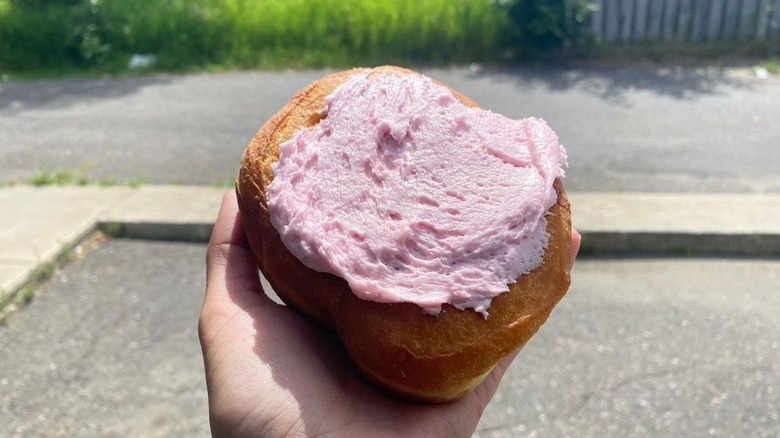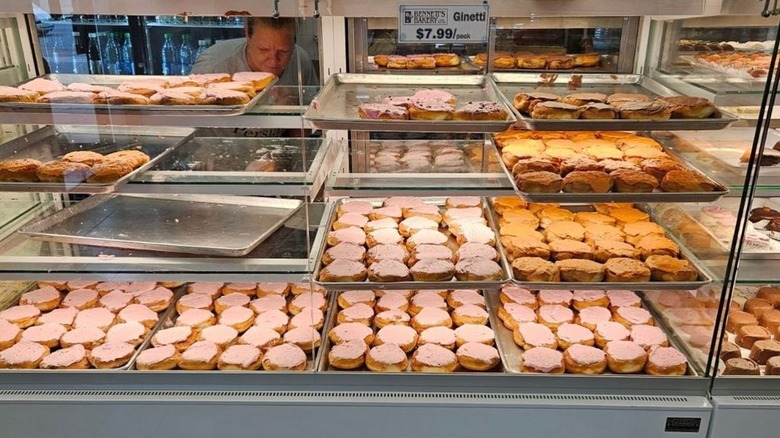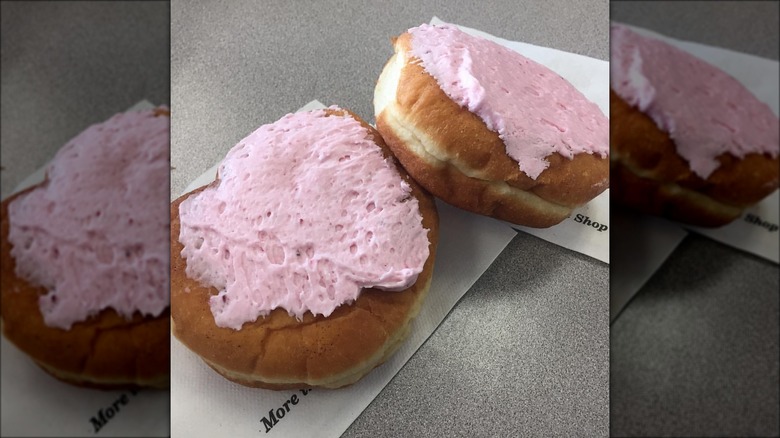What Makes Persian Donuts Unique From Other Pastries?
When you hear the words Persian donut, you're probably thinking of a sweet dessert with roots in ancient Iran, likely introduced to the rest of the world by merchants, traders, and travelers centuries ago. You're picturing a deep-fried delicacy similar to the ancient Greek dessert of loukoumades perhaps — dipped and soaked in honey, rosewater, saffron, or orange blossom syrup and loaded with nuts and warm spices that are so often used to flavor sweets in the region. But Persian donuts are no old-world treats; In fact, they aren't even from modern-day Iran — they are unlike any other doughnut you'd find around the world!
Persian donuts originated thousands of miles away from their namesake region, in Thunder Bay, Ontario, Canada. They are indeed deep-fried balls of dough like other donuts. However, they actually resemble cinnamon rolls in both taste and appearance. But unlike the sugar, butter, and cream cheese icing that goes on top of cinnamon rolls, Persian donuts have one key element that sets them apart: They are slathered in a pale pink berry icing.
Although the exact recipe for a Persian donut isn't common knowledge, you could say that it is a cross between a cinnamon roll and a donut of sorts. It has the same spiced swirls of cinnamon and sugar that's in those sweet rolls but is fried rather than baked, and it comes with a thick, fruity icing that you're more likely to find on a cake.
The Canadian origin of the Persian donut
The Persian donut is an enigmatic dessert shrouded in mystery. While the exact details of its invention are lost with time, what's known is that the donut was created by Thunder Bay resident, Art Bennett, at his namesake bakery in the 1940s. According to local stories, Bennett was working on a new donut one day when in came General John Joseph Pershing — an American World War I General visiting Thunder Bay from the naval base in Duluth, Minnesota a few hours away. The General and the owner soon got talking. Though no one knows the details of that conversation, one can only assume it was riveting because, by the end of it, Bennett had decided to name his new donut after the visitor. And so the Persian donut (inspired by Pershing) came to be.
Art Bennett's was later bought by the Nucci family in 1962 and is now run by brothers Danny, Sandy, and Joe. Despite the change of ownership, however, the Persian donut remains on the menu and has become an indispensable part of Thunder Bay's culture. In fact, the donut's popularity has transcended borders, and it is a much-loved treat in the North American states of Ohio, Maine, Wisconsin, Indiana, Pennsylvania, and Mississippi. The Nuccis alone sell over 100 dozen Persians a day out of Art Bennett (now renamed as Bennett's Bakery) and their second outpost The Persian Man, as well as through packaged donuts sold at supermarkets.
So what's in a Persian donut?
The original recipe created by Bennett is a secret that the Nuccis guard closely. One can only speculate how the Persian donut is made or what it contains, but Danny Nucci did tell TVO Today, "It's similar to a cinnamon bun, but a lot richer. There's eggs in it." He also confirms that the donut is made from a layer of cinnamon placed on sheet dough, which is then rolled and sliced.
However, he states that it's the icing (not to be confused with frosting) that sets their Persian apart. Made from jam and free of added coloring, it features either strawberries or raspberries — or a mix of both – and has some crunch from the tiny seeds. Nucci also told CBC that the donuts are not as sweet as one would expect an iced treat to be and that the recipe uses a secret ingredient to balance any cloying flavor. Those who've tasted the donut speculate it's likely sour cream that does the trick.
Though this is the recipe that Bennett created, there are several variations of the Persian donut. Some swap the berry icing for caramel and peanuts whereas others use dark chocolate. But if you make it to Thunder Bay to try the original, you might want to eat it the way some locals do: Sliced in half and toasted in butter until the frosting caramelizes.



